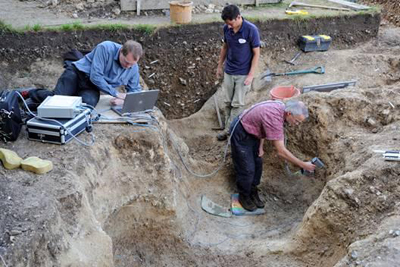 About a mile away from Stonehenge, at the end of the ‘Avenue’ that connects it to the River Avon, archaeologists have discovered a smaller prehistoric site, named – appropriately, after the colour of the 27 Welsh stones it was made of – Bluehenge. The newly discovered stone circle is thought to have been put up 5,000 years ago – which is around the same time work on Stonehenge began – and appears to be a miniature version of it. The two circles stood together for hundreds of years before Bluehenge was dismantled. Researchers believe its stones were used to enlarge Stonehenge during one of a number of redevelopments.
About a mile away from Stonehenge, at the end of the ‘Avenue’ that connects it to the River Avon, archaeologists have discovered a smaller prehistoric site, named – appropriately, after the colour of the 27 Welsh stones it was made of – Bluehenge. The newly discovered stone circle is thought to have been put up 5,000 years ago – which is around the same time work on Stonehenge began – and appears to be a miniature version of it. The two circles stood together for hundreds of years before Bluehenge was dismantled. Researchers believe its stones were used to enlarge Stonehenge during one of a number of redevelopments.
The new circle, unearthed over the summer by researchers from Sheffield University, represents an important find, researchers said Saturday. Although Bluehenge’s monoliths have disappeared, the circle of holes remains. It’s about 60 foot wide, has 27 holes, and the chips of blue stone found in the holes appear to be identical to the blue stones used in Stonehenge.
This new find might just change our view on Stonehenge’s history; it suggests that the creators of Stonehenge originally built two prehistoric stone circles – one with 56 stones at Stonehenge, and another with 27 at Bluehenge. The stones of the smaller circle were eventually worked into the bigger one.
Professor Geoffrey Wainwright, who found the source of the Stonehenge stones in Wales with Professor Darvill, told the DailyMail: ‘This henge is very important because it forms part of the picture of ceremonial monuments in the area and puts Stonehenge into context.” The area surrounding Stonehenge is sometimes dubbed a ‘ritual landscape’ which would include the Durrington Walls Henge (a place for the living), Stonehenge (a place for the dead) and their respective avenues. But no need to say many think that as Stonehenge evolved over thousands of years, it must have had different destinations of use during those differen eras (sometimes known as the three phases of Stonehenge) and that the storyline is more complicated than just a life/death juxtaposition.
More information about the newly discovered Bluehenge should be published in February 2010. And err.. I guess Wessex Archaeology will need to adjust their superb Stonehenge Landscape 3D now?